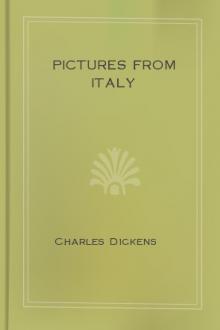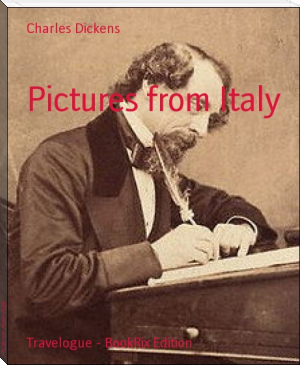Travels Through France And Italy, Tobias Smollett [love novels in english .TXT] 📗

- Author: Tobias Smollett
Book online «Travels Through France And Italy, Tobias Smollett [love novels in english .TXT] 📗». Author Tobias Smollett
Great Body Of Water, As Fills The Basin Of The Source, The Roman
Basin, Two Large Deep Canals Three Hundred Feet In Length, Two
Vast Basins That Make Part Of The Great Canal, Which Is Eighteen
Hundred Feet Long. Eighteen Feet Deep, And Forty-Eight Feet
Broad. When I Saw It, There Was In It About Eight Or Nine Feet Of
Water, Transparent As Crystal. It Must Be Observed, However, For
The Honour Of French Cleanliness, That In The Roman Basin,
Through Which This Noble Stream Of Water Passes, I Perceived Two
Washerwomen At Work Upon Children's Clouts And Dirty Linnen.
Surprized, And Much Disgusted At This Filthy Phaenomenon, I Asked
By What Means, And By Whose Permission, Those Dirty Hags Had Got
Down Into The Basin, In Order To Contaminate The Water At Its
Fountain-Head; And Understood They Belonged To The Commandant Of
The Place, Who Had Keys Of The Subterranean Passage.
Part 7 Letter 10 (Montpellier, November 10, 1763.) Pg 112
Fronting The Roman Baths Are The Ruins Of An Antient Temple,
Which, According To Tradition, Was Dedicated To Diana: But It Has
Been Observed By Connoisseurs, That All The Antient Temples Of
This Goddess Were Of The Ionic Order; Whereas, This Is Partly
Corinthian, And Partly Composite. It Is About Seventy Foot Long,
And Six And Thirty In Breadth, Arched Above, And Built Of Large
Blocks Of Stone,
Exactly Joined Together Without Any Cement. The Walls Are Still
Standing, With Three Great Tabernacles At The Further End,
Fronting The Entrance. On Each Side, There Are Niches In The
Intercolumniation Of The Walls, Together With Pedestals And
Shafts Of Pillars, Cornices, And An Entablature, Which Indicate
The Former Magnificence Of The Building. It Was Destroyed During
The Civil War That Raged In The Reign Of Henry Iii. Of France.
It Is Amazing, That The Successive Irruptions Of Barbarous
Nations, Of Goths, Vandals, And Moors; Of Fanatic Croisards,
Still More Sanguinary And Illiberal Than Those Barbarians, Should
Have Spared This Temple, As Well As Two Other Still More Noble
Monuments Of Architecture, That To This Day Adorn The City Of
Nismes: I Mean The Amphitheatre And The Edifice, Called Maison
Carree--The Former Of These Is Counted The Finest Monument Of The
Kind, Now Extant; And Was Built In The Reign Of Antoninus Pius,
Who Contributed A Large Sum Of Money Towards Its Erection. It Is
Of An Oval Figure, One Thousand And Eighty Feet In Circumference,
Capacious Enough To Hold Twenty Thousand Spectators. The
Architecture Is Of The Tuscan Order, Sixty Feet High, Composed Of
Two Open Galleries, Built One Over Another, Consisting Each Of
Threescore Arcades. The Entrance Into The Arena Was By Four Great
Gates, With Porticos; And The Seats, Of Which There Were Thirty,
Rising One Above Another, Consisted Of Great Blocks Of Stone,
Many Of Which Still Remain. Over The North Gate, Appear Two
Bulls, In Alto-Relievo, Extremely Well Executed, Emblems Which,
According To The Custom Of The Romans, Signified That The
Amphitheatre Was Erected At The Expence Of The People. There Are
In Other Parts Of It Some Work In Bas-Relief, And Heads Or Busts
But Indifferently Carved. It Stands In The Lower Part Of The
Town, And Strikes The Spectator With Awe And Veneration. The
External Architecture Is Almost Intire In Its Whole Circuit; But
The Arena Is Filled Up With Houses--This Amphitheatre Was
Fortified As A Citadel By The Visigoths, In The Beginning Of The
Sixth Century. They Raised Within It A Castle, Two Towers Of
Which Are Still Extant; And They Surrounded It With A Broad And
Deep Fossee, Which Was Filled Up In The Thirteenth Century. In
All The Subsequent Wars To Which This City Was Exposed, It Served
As The Last Resort Of The Citizens, And Sustained A Great Number
Of Successive Attacks; So That Its Preservation Is Almost
Miraculous. It Is Likely, However, To Suffer Much More From The
Gothic Avarice Of Its Own Citizens, Some Of Whom Are Mutilating
It Every Day, For The Sake Of The Stones, Which They Employ In
Their Own Private Buildings. It Is Surprizing, That The King's
Part 7 Letter 10 (Montpellier, November 10, 1763.) Pg 113Authority Has Not Been Exerted To Put An End To Such Sacrilegious
Violation.
If The Amphitheatre Strikes You With An Idea Of Greatness, The
Maison Carree Enchants You With The Most Exquisite Beauties Of
Architecture And Sculpture. This Is An Edifice, Supposed Formerly
To Have Been Erected By Adrian, Who Actually Built A Basilica In
This City, Though No Vestiges Of It Remain: But The Following
Inscription, Which Was Discovered On The Front Of It, Plainly
Proves, That It Was Built By The Inhabitants Of Nismes, In Honour
Of Caius And Lucius Caesar, The Grandchildren Of Augustus By His
Daughter Julia, The Wife Of Agrippa.
C. Caesari. Avgvsti. F. Cos.
L Caesari. Avgmi. F. Cos.
Designato.
Principibvs Ivventutis.
To Caius And Lucius Caesar, Sons Of Augustus, Consuls Elect,
Princes Of The Roman Youth.
This Beautiful Edifice, Which Stands Upon A Pediment Six Feet
High, Is Eighty-Two Feet Long, Thirty-Five Broad, And Thirty-Seven
High, Without Reckoning The Pediment. The Body Of It Is
Adorned With Twenty Columns Engaged In The Wall, And The
Peristyle, Which Is Open, With Ten Detached Pillars That Support
The Entablature. They Are All Of The Corinthian Order, Fluted And
Embellished With Capitals Of The Most Exquisite Sculpture, The
Frize And Cornice Are Much Admired, And The Foliage Is Esteemed
Inimitable. The Proportions Of The Building Are So Happily
United, As To Give It An Air Of Majesty And Grandeur, Which The
Most Indifferent Spectator Cannot Behold Without Emotion. A Man
Needs Not Be A Connoisseur In Architecture, To Enjoy These
Beauties. They Are Indeed So Exquisite That You May Return To
Them Every Day With A Fresh Appetite For Seven Years Together.
What Renders Them The More Curious, They Are Still Entire, And
Very Little Affected, Either By The Ravages Of Time, Or The Havoc
Of War. Cardinal Alberoni Declared, That It Was A Jewel That
Deserved A Cover Of Gold To Preserve It From External Injuries.
An Italian Painter, Perceiving A Small Part Of The Roof Repaired
By Modern French Masonry, Tore His Hair, And Exclaimed In A Rage,
"Zounds! What Do I See? Harlequin's Hat On The Head Of Augustus!"
Without All Doubt It Is Ravishingly Beautiful. The Whole World
Part 7 Letter 10 (Montpellier, November 10, 1763.) Pg 114Cannot Parallel It; And I Am Astonished To See It Standing
Entire, Like The Effects Of Inchantment, After Such A Succession
Of Ages, Every One More Barbarous Than Another. The History Of
The Antiquities Of Nismes Takes Notice Of A Grotesque Statue,
Representing Two Female Bodies And Legs, United Under The Head Of
An Old Man; But, As It Does Not Inform Us Where It Is Kept, I Did
Not See It.
The Whole Country Of Languedoc Is Shaded With Olive Trees, The
Fruit Of Which Begins To Ripen, And Appears As Black As Sloes;
Those They Pickle Are Pulled Green, And Steeped For Some Time In
A Lye Made Of Quick Lime Or Wood Ashes, Which Extracts The Bitter
Taste, And Makes The Fruit Tender. Without This Preparation It Is
Not Eatable. Under The Olive And Fig Trees, They Plant Corn And
Vines, So That There Is Not An Inch Of Ground Unlaboured: But
Here Are No Open Fields, Meadows, Or Cattle To Be Seen. The
Ground Is Overloaded; And The Produce Of It Crowded To Such A
Degree, As To Have A Bad Effect Upon The Eye, Impressing The
Traveller With The Ideas Of Indigence And Rapacity. The Heat In
Summer Is So Excessive, That Cattle Would Find No Green Forage,
Every Blade Of Grass Being Parched Up And Destroyed. The Weather
Was Extremely Hot When We Entered Montpellier, And Put Up At The
Cheval Blanc, Counted The Best Auberge In The Place, Tho' In Fact
It Is A Most Wretched Hovel, The Habitation Of Darkness, Dirt,
And Imposition. Here I Was Obliged To Pay Four Livres A Meal For
Every Person In My Family, And Two Livres At Night For Every Bed,
Though All In The Same Room: One Would Imagine That The Further
We Advance To The Southward The Living Is The Dearer, Though In
Fact Every Article Of Housekeeping Is Cheaper In Languedoc Than
Many Other Provinces Of France. This Imposition Is Owing To The
Concourse Of English Who Come Hither, And, Like Simple Birds Of
Passage, Allow Themselves To Be Plucked By The People Of The
Country, Who Know Their Weak Side, And Make Their Attacks
Accordingly. They Affect To Believe, That All The Travellers Of
Our Country Are Grand Seigneurs, Immensely Rich And Incredibly
Generous; And We Are Silly Enough To Encourage This Opinion, By
Submitting Quietly To The Most Ridiculous Extortion, As Well As
By Committing Acts Of The Most Absurd Extravagance. This Folly Of
The English, Together With A Concourse Of People From Different
Quarters, Who Come Hither For The Re-Establishment Of Their
Health, Has Rendered Montpellier One Of The Dearest Places In The
South Of France. The City, Which Is But Small, Stands Upon A
Rising Ground Fronting The Mediterranean, Which Is About Three
Leagues To The Southward: On The Other Side Is An Agreeable
Plain, Extending About The Same Distance Towards The Mountains Of
The Cevennes. The Town Is Reckoned Well Built, And What The
French Call Bien Percee; Yet The Streets Are In General Narrow,
And The Houses Dark. The Air Is Counted Salutary In Catarrhous
Consumptions, From Its Dryness And Elasticity: But Too Sharp In
Cases Of Pulmonary Imposthumes.
Part 7 Letter 10 (Montpellier, November 10, 1763.) Pg 115
It Was At Montpellier That We Saw For The First Time Any Signs Of
That Gaiety And Mirth For Which The People Of This Country Are
Celebrated. In All Other Places Through Which We Passed Since Our
Departure From Lyons, We Saw





Comments (0)